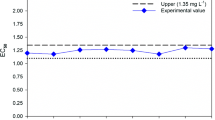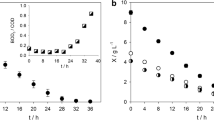Abstract
Toxicity of effluents after treatment in an anaerobic fermentation system for hydrogen production is evaluated with three biotests: The zebrafish Danio rerio embryo test, the Thamnotoxkit F and the Daphtoxkit FTM magna. Samples were classified from “very” to “extremely toxic”. Average toxicity values for zebrafish were 1.55% (24 h) and 0.75% (48 h), for Thamnocephalus 0.69% (24 h) and for Daphnia 2.51% (24 h) and 1.82% (48 h). Statistical analysis between physicochemical parameters and LC50 values revealed that PO −34 , SO −24 , NH3N and NO3 − have the major contribution to toxicity. Based on results, this treatment is considered an environmentally ineffective way of managing the specific wastes.

Similar content being viewed by others
References
AWWA, APHA, WPCF (1989) Standard methods for the examination of water and wastewater, 17th edn. American Public Health Association, Washington DC, USA
Daphtoxkit FTM Magna (1996) Crustacean toxicity screening test for freshwater, standard operational procedure. MicroBioTests, Nazareth, Belgium
Demirel B, Yenigun O, Onay TT (2005) Anaerobic treatment of dairy wastewaters: a review. Process Biochem 40:2583–2595. doi:10.1016/j.procbio.2004.12.015
DIN 38 415-T6 (2001) Bestimmung der nicht akut giftigen Wirkung von Abwasser auf die Entwicklung von Fischeiern über Verdünnungsstufen (T6). Deutsche Einheitsverfahren zur Wasser-Abwasser und Schlammuntersuchung
Garrido JM, Omil F, Arrojo B, Mendez R, Lema JM (2001) Carbon and nitrogen removal from a wastewater of an industrial dairy laboratory with a coupled anaerobic filter-sequencing batch reactor system. Water Sci Technol 43(3):249–256
Hamdani A, Mountadar M, Assobhei O (2005) Comparative study of the efficacy of three coagulants in treating dairy factory waste water. Int J Dairy Technol 58(2):83–88. doi:10.1111/j.1471-0307.2005.00198.x
Handajani M (2004) Degradation of whey in an anaerobic fixed bed (AnFB) reactor. Dissertation. Universitat Karlsruhe (TH), Fakultat fur Bauingenieur, Geo-und Umweltwissenschaften
Hill AJ, Teraoka H, Heideman W, Peterson RE (2005) Zebrafish as a model vertebrate for investigating chemical toxicity. Toxicol Sci 86(1):6–19. doi:10.1093/toxsci/kfi110
Isidori M, Parrella A, Piazza CML, Strada R (2000) Toxicity screening of surface waters in southern Italy with Toxkit microbiotests. In: Persoone G, Janssen CR, De Coen W (eds) New microbiotests for routine toxicity screening and biomonitoring. Kluwer Academic/Plenum Publishers, New York, pp 289–293
Janssen CR, Vangheluwe M, Van Sprang P (2000) A brief review and critical evaluation of the status of microbiotests. In: Persoone G, Janssen CR, De Coen W (eds) New microbiotests for routine toxicity screening and biomonitoring. New York, Kluwer Academic/Plenum Publishers, pp 27–37
Kammann U, Biselli S, Hühnerfuss H, Reineke N, Theobald N, Vobach M, Wosniok W (2004) Genotoxic and teratogenic potential of marine sediment extracts investigated with comet assay and zebrafish test. Environ Pollut 132(2):279–287. doi:10.1016/j.envpol.2004.04.021
Karadima C, Iliopoulou–Georgudaki J (2006) Application of three bioassays for acute toxicity evaluation of raw dairy effluents. Fresenius Environ Bull 15(6):497–502
Koivisto S (1995) Is Daphnia magna an ecologically representative zooplankton species in toxicity tests? Environ Pollut 90(2):263–267. doi:10.1016/0269-7491(95)00029-Q
Mishra S, Barik SK, Ayyappan S, Mohapatra BC (2000) Fish bioassays for evaluation of raw and bioremediated dairy effluent. Bioresour Technol 72(3):213–218. doi:10.1016/S0960-8524(99)00124-8
Nagel R (2002) DarT: the embryo test with the Zebrafish Danio rerio-a general model in ecotoxicology and toxicology. ALTEX : Alternativen zu Tierexperimenten 19(1):38–48
OECD Guideline for testing of chemicals (2004) Fish embryo toxicity test with the zebrafish Danio rerio
Thamnotoxkit FTM (1995) Crustacean toxicity screening test for freshwater. Standard Operational Procedure. MicroBioTests, Nazareth, Belgium
Acknowledgment
This paper is part of the 03ED375 research project, implemented within the framework of the “Reinforcement Programme of Human Research Manpower” (PENED) and co-financed by National and Community Funds (20% from the Greek Ministry of Development-General Secretariat of Research and Technology and 80% from E.U.-European Social Fund).
Author information
Authors and Affiliations
Corresponding author
Rights and permissions
About this article
Cite this article
Karadima, C., Theodoropoulos, C. & Iliopoulou-Georgudaki, J. Environmental Hazard Assessment of Cheese Manufacturing Effluent Treated for Hydrogen Production. Bull Environ Contam Toxicol 83, 428–434 (2009). https://doi.org/10.1007/s00128-009-9712-x
Received:
Accepted:
Published:
Issue Date:
DOI: https://doi.org/10.1007/s00128-009-9712-x




